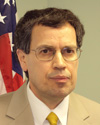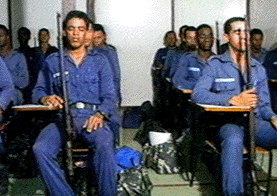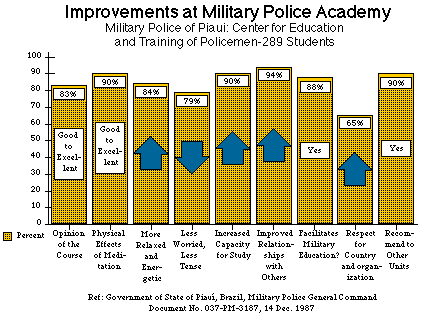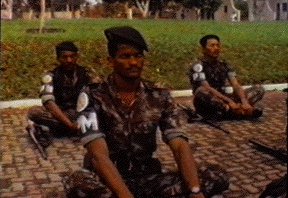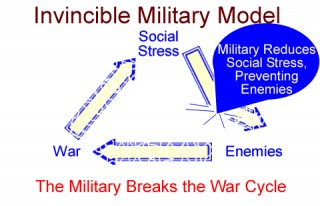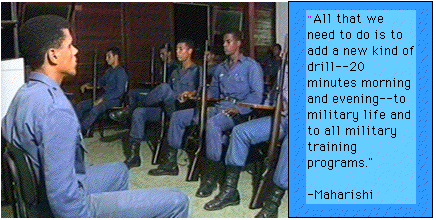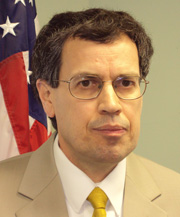Published in Police Writers
By: John Theobald, M.S.
Former N.Y.P.D. Officer and Former Professor of Criminal Justice at the New York Institute of Technology
With: David Leffler, Ph.D.
Executive Director, Center for Advanced Military Science (CAMS)
Introduction
Between 1987 and 1988 a number of Brazilian state governments introduced the Transcendental Meditation - program to their military police. More than 26,000 police officers of all ranks were instructed. Military Police work is often dangerous and extremely stressful. Extensive scientific research shows that, through the Transcendental Meditation program, practitioners experience greater calm, clearer perception, broader comprehension, greater alertness, and faster reactions. The Transcendental Meditation program complements police officer training.
In 1965 I was a member of the New York City Police Department, assigned to a specialized anti-crime unit. In this capacity, I saw firsthand the types of stressors police officers were subject to, and the maladaptive ways in which many dealt with them. I subsequently left the department and returned to college and then graduate school. I eventually started a criminal justice program through the continuing education department of the New York Institute of Technology. The program grew, and in the 1970s reached an enrollment of 12,000 police officers from various police agencies across the New York metropolitan area.At that time it was becoming increasingly clear that the stress factor in police work was manifesting in high rates of divorce, alcohol abuse, suicides, and other acting-out behaviors. Having experienced it firsthand, I was determined to seek some method that could help ameliorate this situation.
I began to research the various stress-reduction methods available. The Transcendental Meditation - program appeared to be the best approach because it was widely available, could be practiced anywhere at any time, and had unparalleled success at addressing these personal problems faced by police. Research indicated that Transcendental Meditation (TM - ) practice could help alleviate the negative effects of stress. It was clear that the TM technique would also increase awareness of potentially dangerous situations, preparing anyone for any possible outcome.
Shortly after learning the TM technique, I noticed the marked reduction in my own stress levels, and decided to make this opportunity available to the students in the college program. It was only later, when many police officers were practicing the TM technique, that I fully realized how beneficial it truly was.
I arranged through centers in the ten metropolitan counties to teach any police officers who wanted to learn. At this time, college courses were offered in various police precincts and other locations throughout the New York Metropolitan area. Introductory TM lectures were offered at some of these locations, with interested officers going to their individual TM centers to learn the practice. Word spread to their associates and about 6,000 police officers learned to meditate.
Feedback from students was received for many years, both in the college program and, in some cases, years later, by individual police officers who said they were "still TM-ing." Comments from students consistently indicated overwhelmingly positive results. One of the most common reports was an increase in their shooting scores. Others reported feeling more aware, especially in life-threatening situations. This is important because in an effort to protect and save lives, law enforcement officers may sometimes resort to using deadly force.
For example, there was a story of an officer and his partner who were called to a situation in a very dangerous part of New York City. While walking in an alley, they were ambushed. A shot rang out, and his partner fell wounded to the ground. This officer drew his revolver and quickly shot five assassins, killing four and disabling the fifth. He later reported if it were not for his regular TM practice, he would have been killed. Despite the overwhelming odds against him, the policeman said he was able to maintain his composure under fire. He skillfully and accurately shot his weapon during this dangerous and highly stressful situation. (The revolvers used by New York area police at that time could only fire six rounds, so the situation was much more critical than it would be in modern times where weapons can fire fifteen or more rounds.)
Police officers must be able to function in the present moment on a daily basis. Effective police work depends on what's thought of as "street sense" or intuition. Police have to be more aware to read these subtle street signs. At the same time, they should not be overwhelmed by memories of previously stressful experiences; they must not overreact to situations. The TM technique removes deeply rooted fatigue and stress. The nervous system is strengthened and calmed. The mind no longer overreacts to old memories, which no longer have the same stressful influence. TM practice helps police officers survive these situations. They remain calm yet vigilant on the job.
One clear example of the ability to recognize subtle cues in the environment is the phenomena of microexpressions. Microexpressions are brief, involuntary facial expressions people exhibit according to the emotions they are experiencing at the moment. These expressions usually occur in high-stakes situations, where people have something to lose or gain. Israeli police and security, as well as TSA officers in the US, are being trained to recognize these subtle expressions. Unlike regular facial expressions, microexpressions are difficult to fake. They are the same across various cultures. Researcher Paul Ekman expanded a list of basic emotions, including a range of positive and negative emotions, not all of which are encoded in facial muscles. These emotions are amusement, contempt, embarrassment, excitement, guilt, pride, relief, satisfaction, pleasure, and shame. They are very brief in duration, lasting only 1/25 to 1/15 of a second. Obviously, if a police officer or a soldier in Iraq approaches a person, his ability to read the situation quickly and accurately is a matter of life and death. Does the person have a gun or a bomb? Is the person setting up a crime or a terrorist act? All this information needs to be processed in a moment's time. The ability of the TM technique to reduce stress and increase calmness and alertness gives officers the ability to accurately and more intuitively read these microexpressions.
Gaining a Competitive and Strategic Edge on the Beat
This chart illustrates the significant improvements in health and discipline which were experienced by the officers and cadets practicing the Transcendental Meditation - program in the State of Bahia, Brazil. These improvements resulted in improved community relations as measured by a dramatic increase (1,206%) in the number of positive reports received by the Police Department from the citizens of Salvador.
Such anecdotal reports of increased performance as well as decreased indicators of stress appear to be backed by extensive scientific research. For instance, studies documenting the benefits of the TM program show that police officers could gain a competitive and strategic edge on the beat. A study showed that speed, agility, reactions, coordination, endurance, and perception improved after learning the TM program. In other studies, three months of practicing the TM technique resulted in subjects showing significantly increased field independence, i.e., increased ability to focus, increased stability of spatial orientation, broader comprehension, and increased resistance to distraction, as compared to controls. In other words, police officers can maintain a sense of the whole situation, while focusing in on a critical aspect of it, without being distracted.
Other research has measured a greater ability to assimilate and structure experience, improved memory and learning ability, increased creativity, and greater autonomic stability. Among the improvements are enhanced neurological efficiency, faster choice reaction time, improved self-confidence, increased self-reliance, and greater inner control. Holistic growth has been indicated by psychophysiological means, such as measures of increased global EEG coherence, and through psychological tests of intelligence, moral reasoning, and personality. (References to the above mentioned research are available in an online paper originally published by India Defence Consultants.)
Dr. Frederick Travis, Director, Center for Brain, Consciousness, and Cognition at Maharishi University of Management, published an article about the potential benefits of the Transcendental Meditation program for those in law enforcement in the FBI Law Enforcement Bulletin (pp. 26--32, May 2009). In the article, entitled Brain Functioning as the Ground for Spiritual Experiences and Ethical Behavior about the potential benefits of the Transcendental Meditation program for those in law enforcement, Travis concluded that his "research has indicated that practice of the TM technique leads to increased frontal brain integration, faster habituation to stressful stimuli, and higher moral reasoning." He asserts that inner experiences during TM practice enliven frontal coherence, which builds global circuits to place individual experiences in a larger framework. In this vein, spiritual experiences could provide the inner armor to protect police officers from the noxious effects of stress and negative experiences.
The TM technique is a simple, nonreligious, psychophysiological practice, now demonstrated in over 600 research studies to reduce a wide variety of stress-related problems. It is practiced twice a day for twenty minutes and is so easy to learn that anyone who can think a thought can practice it. The TM technique carries one's awareness to a profound level of rest, clears out deep-seated stress, and revitalizes overactive nervous systems. Meta-analyses published in peer-reviewed journals provide more evidence for the superior effectiveness of the TM technique over other practices in the areas of anxiety reduction, reduced high blood pressure, self-development, physiological relaxation, improved psychological outcomes, and decreased use of drugs, alcohol, and cigarettes.
In the Police Academy of Piaui, Brazil, meditating cadets likewise experienced significant improvements in health, behavior, attitude, and academic performance.
Scientific research also suggests that meditation can lessen overall stress. Practitioners of the TM technique are more acutely aware of their immediate surroundings, and are able to respond appropriately without hesitation. This is an obvious benefit for the police and military, especially under today's situations where there are high degrees of danger and uncertainty.
Currently, the work of military forces has become increasingly similar to police work in high-crime urban areas. Indeed, many American police officers who also serve in the military reserves frequently deploy to help train indigenous police and troops, making such deployments more similar to city police work than to past traditional uses of the military.
In addition to the aforementioned studies of heightened performance under stress, the practitioners of the TM technique also showed a more rapid physiological recovery from a stressful stimulus, as gauged by habituation of the skin resistance response. A number of other studies have found beneficial effects of the TM program on stress-induced neuroendocrine dysfunctions that contribute to cardiovascular and other chronic diseases. Also, over twenty-five studies have shown that the TM program fosters significant reductions in substance abuse, such as tobacco, alcohol, and all types of illegal and prescribed drugs. (To find out more about the scientific research conducted on the TM program, visit http://www.tm.org/research-on-meditation).
The increasing demands of contemporary military police work are reflected in the many stress-related problems experienced by such personnel, including psychosomatic disease, high suicide rates, high divorce rates, reduced life span, increased disciplinary problems, and poor community relations. The holistic Transcendental Meditation program eliminates these stress-related problems and unfolds the police officer's full potential.
Even with impressive results like this, critics might argue that police and military personnel would not be willing to practice the TM technique. But 6,000 thousand active New York City Police, many working in high-crime areas, had no problem practicing the TM technique. Some resistance to the practice might initially be the case, but the results of the meditating officers speak for themselves. Those concerned that a perceived "machismo pushback" regarding meditation may prevent police from learning to meditate should think back through history to great examples of alert, ready, and finely tuned warriors. According to combat veteran Jerry Yellin, author of The Resilient Warrior: Healing the Hidden Wounds of War, an ideal might be martial arts experts like the samurai. They represented the total integration, the total union, of mind, body, and spirit -- quick, clear thinking, combined with a precise strong body, working as one. The improved shooting scores of NYC area police support this integrated, intimate connection between mind, body, and spirit, which is now beginning to be rediscovered.
Could TM practice be part of the training regimen for police and military today? Yes! The TM program has already been implemented in Latin American countries like Ecuador. For instance, an Ecuadorian Military Police general was very receptive to the concept of meditating officers and decided to have his warriors instructed in the TM technique on 8 March 2010. As a test case, the general selected two units from training centers where young cadets received their six months' basic military police training before they were sent to operational units. Each training unit had 300 cadets who were taught the TM technique, and 200 of these received advanced training in the practice. The general set the time and place for the cadets to practice their meditation program in a group in accordance with their duty routine.
Were the cadets willing participants in such an unusual endeavor? Again, yes! A study was conducted by Ecuadorian army psychologists to assess the value of the TM program after officers had been practicing it for one month. The results? Over 96% of the military police officer cadets thought the TM technique was a very practical activity. Why were they convinced? As the study showed, 92% felt their performance in activity had improved and they were better able to deal with stress; 96% declared their relationships with others had improved; and 95% said their practice of the TM technique was completely satisfying.
According to Dr. Travis, research shows that all meditation practices are not the same. Travis reports that "recent studies show meditation practices have been classified into three categories: Focused Attention, Open Monitoring, and Automatic Self-Transcending. Techniques in the Automatic Self-Transcending category transcend their own procedure -- take the attention out of thinking, analyzing, controlling, or watching to a state of pure consciousness (also known as Transcendental Consciousness, a state beyond psychophysiological conditioning, to be discussed in more detail later). The Transcendental Meditation technique is in this category. During TM practice, research has indicated that there is integrated functioning of the brain.
The TM technique is also different because it turns one's attention inward to experience deeper levels of thought, until one goes beyond active thought and the mind comes to a state of complete inner rest. The mind is alert with no content. There is inner wakefulness, and a feeling of calm and peace that gradually infuses into the rest of activity. This is the state of restful alertness. Global alpha EEG is seen during TM, indicating that the brain is functioning in an integrated orderly manner. The brain functions with significantly greater coherence, the mind is freed from disturbing thoughts and feelings, and the body gains deep rest.
Different meditation techniques use different procedures, have different effects on brain functioning, and so lead to different results. Meta-analyses report that TM practice results in higher levels of self-actualization and greater decreases in anxiety than other meditations. In the bigger picture, research on TM practice reports significant effects on psychological measures -- improved moral reasoning, creativity, cognitive flexibility, coping and problem solving; improved health -- reductions in blood pressure and in hospitalization; and significant improvement in social interactions. Police or military units are only as good as their numbers of healthy personnel.
It is well known that stress-related problems can ultimately lead to poor health. Today's police and military personnel need -- and deserve -- every opportunity to regain and/or sustain their health. Research also shows that practitioners of the TM technique rise to a higher level of overall physical and psychological wellness. For instance, a pioneering 1987 study in Psychosomatic Medicine, a mainstream medical journal, monitored for five years the medical care utilization of 2,000 people who regularly practiced the TM technique. The findings: 50 percent fewer doctor visits and hospital admissions than among nonmeditators of comparable age, gender, profession, and insurance terms. The cost savings in health care alone would justify implementation of the TM program by police and military, in this era of reduced financial budgets.
A new study on the health care cost effectiveness of the TM program was recently published in the American Journal of Health Promotion, 2011 Sept.--Oct.; 26(1):56--60. The study, conducted by Dr. Robert Herron, director of the Center for Health Systems Analysis, found that people with consistently high health care costs experienced a 28 percent cumulative decrease in physician fees after an average of five years practicing the stress-reducing Transcendental Meditation technique compared with their baseline.
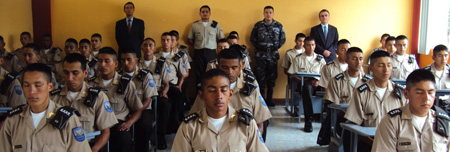
Equadorian warriors meditate in groups to protect their nation.
(Image by Dr. David Leffler) Details DMCA
Ecuadorian Military Police conduct group meditation to prevent crime and protect their nation
Militaries in Latin American are now also beginning to use the group practice of the TM and advanced TM-Sidhi - programs as a scientifically verified way to prevent crime, war, and terrorism. When used in a military context, these meditation practices are known as Invincible Defense Technology (IDT).
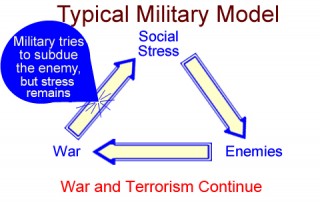
Old defense approach: the military fails to address social stress.
New Invincible Defense Technology approach addresses social stress, thereby ending crime, war, terrorism and violence.
For example, because of its initial success in teaching the TM technique to its military police, Ecuador is now establishing a "Prevention Wing of the Military," a group of their military police personnel that practices the advanced TM-Sidhi program (an advanced program that integrates inner silence into activity more directly) together twice daily. Groups that reach a critical size threshold have been scientifically shown to reduce collective societal stress.
Stressed individuals collectively contribute to social stress. Crime, war, and terrorism are hypothesized to be caused by collective societal stress. The absence of collective stress translates into the absence of tension in cities, between countries, and between religious groups. By applying this benign nonlethal and nondestructive technology, police and military can reduce societal stress, prevent crime, and ultimately prevent enemies from arising.
Over fifty scientific studies have found that when sufficiently large groups practice the TM-Sidhi program together twice daily, measurable positive changes take place throughout society as a whole. The studies show decreased violence, crime, car accidents, and suicides, and improved quality of life in society.
One of those studies was conducted in the summer of 1993 in Washington, D.C., and was later published in Social Indicators Research. Dr. John Hagelin, Harvard-trained physicist, served as the Project Director for this successful crime-reducing experiment. In an article, The Power of The Collective, published in Shift magazine, he explained the details of the study:
We collaborated with the local police department, the FBI, and 24 leading, independent criminologists and social scientists from major institutions, including the University of Maryland, the University of Texas, and Temple University, who used highly sophisticated research tools to control for variables such as weather. Everyone ended up agreeing on the language, the analysis, and the results, and those results were quite astonishing.... [The predicted reduction was 15 to 20 percent, and crime rate actually dropped by 23.3 percent.] Just before the study, the Washington, D.C., chief of police went on television and said something like, "It's gonna take a foot of snow in June to reduce crime by 20 percent." But he allowed his department to participate in the experiment by collecting and analyzing the data. In the end, the police department signed on as one of the authors of a published paper.
A study published in the Journal of Social Behavior and Personality found that the likelihood that these societal improvements were due to chance is less than one in a quintillion. A global-scale study published in the Journal of Offender Rehabilitation documented a significant drop in international terrorism when IDT groups were large enough to affect the global population. Terrorism returned to previous levels after the experiment was over and meditators returned to their homes.
IDT's causal mechanism is not completely understood. An explanation of the causality of IDT in biological terms was proposed in a study in the Journal of Social Behavior and Personality (Walton et al., 2005, 17: 339--373). Serotonin, a powerful neurotransmitter, has been shown to produce feelings of happiness, contentment, and even euphoria. Research indicates that low levels of serotonin correlate with aggression, poor emotional moods, and violence. The study indicated that when the size of a group of IDT experts changed, serotonin production of people in the nearby community changed correspondingly. Since results were statistically significant, this study offers a plausible neurophysiologic mechanism that may explain reduced aggression and hostility in a whole society.
An increase in serotonin activity and a decrease in cortisol appear to be associated with the experience of transcendental consciousness in the advanced individual TM practitioner. TM practice gives rise to increased coherence in the brain, and scientists speculate that this enlivens coherence within the collective consciousness of society. Apparently, the effect is amplified through group practice. This increased coherence is seen in terms of increased positive effects throughout society.
Another study, published in the Journal of Scientific Exploration by prominent meditation researcher Dr. David Orme-Johnson, answers questions raised about the previous research on IDT. In addition, an article entitled "Peace in the Middle East: Scientific solution to a political problem?" and published in Beirut-Online News asserts that peace in this troubled region is easily within reach. This article also features quotes and Internet links to other articles by military-related leaders worldwide who support implementation of IDT.
Prevention Wings of the Police and MilitaryIDT introduces a new role for the police and military: "Prevention Wings" whose purpose is to prevent enemies from arising. As noted above, this new approach is supported by over fifty scientific studies.
Military Police meditating in a highly acclaimed Transcendental Meditation program for Military Police in Brazil, 1987--88.
IDT can create victory before war, and can assist in peacemaking, peacekeeping, and peacebuilding. The size of the Prevention Wing would usually be only a small percentage of a nation's police and/or military personnel.
In the 1990s, the militaries of Mozambique and Ecuador successfully field-tested land-based Prevention Wings. Sea-based Prevention Wings are theoretically possible: for example, carrier battle groups supporting IDT experts could be deployed to the Persian Gulf to reduce tensions in the Middle East, without directly penetrating borders.
Since the primary function of the police and military is to prevent crime and terrorism and to protect the civilian population, we urge the police and the armed forces of all countries to consider this approach. Today's police and military personnel train their minds and bodies, but mostly separately. They fill their minds with information about how to respond to every imaginable situation, and train their bodies for strength and endurance. Strong protective armor is provided to protect their bodies from physical harm, but nothing for their minds to protect them from stress. Research on the TM technique indicates that the practice produces beneficial effects for the mind and body, opposite to those of chronic stress.
In addition, the TM technique is a portable strategy. After learning the technique, all one needs is a comfortable place to sit and close the eyes. No additional resources are needed. The self-reliance of this approach appeals to the police "protector" and military "warrior mindset." TM offers an approach that can not only help save precious minds and lives but also save money in the process during these difficult and uncertain financial times.
Copyright - 2011 John Theobald and David Leffler
Editor's Note: Readers may find the Invincible Defense Technology (IDT) article entitled "Utilizing Powerful Peace-Creating Technologies to Combat Cyber Warfare" by Maj. Gen. (Ret.) Kulwant Singh and Dr. David Leffler to be of further interest. It was originally submitted as part of the report "Future of Information Warfare and Information Operations" presented by Dr. Marvin J. Cetron, President, Forecasting International at the U.S. Army War College, Carlisle, PA, on March 18, 2009. This conference was sponsored by JIOPO [Joint Information Operations Program Office], CIA [Central Intelligence Agency], DIA [Defense Intelligence Agency] and NSA [National Security Agency]. The original IDT article was expanded by Singh and Leffler and later published in the September 2009 American Heroes Press Newsletter. It is now available online at Military Writers.
![]() John Theobald received his B.S. in Behavioral Science/Criminal Justice (cum laude) at the New York Institute of Technology, and an M.S. in Counseling and Psychological Testing with a minor in research design from Nova University. His program provided an extensive background in counseling psychology and testing, with an emphasis on psychological testing, and on the physiological and quantitative aspects of rehabilitation. John was an honor graduate of the New York City Police Academy. (At that time college credits were granted for graduating from the academy.) He served in the New York City Police Department (NYPD) where he received special Anti-Terrorist Training and worked a variety of assignments, including uniform patrol, undercover and plain clothes, drug and anti-crime task force, and administrative duties. While serving as an administrative assistant to the commanding officer of the Queens Task Force, NYPD, John received additional training in forensic science and investigative techniques, and later became, and still is, a Licensed Private Investigator. He also served as a Probation Officer in Hawaii. John developed the College Accelerated Program for Police, a college degree program designed for full-time police officers in the New York area. He served as coordinator for this program and assumed the directorship of the Student Service Department, when the enrollment reached 12,000 students. His paper, "Three Alternative Systems of Criminal Defense: A Comparative Analysis," was published in Perspectives in Criminology.
John Theobald received his B.S. in Behavioral Science/Criminal Justice (cum laude) at the New York Institute of Technology, and an M.S. in Counseling and Psychological Testing with a minor in research design from Nova University. His program provided an extensive background in counseling psychology and testing, with an emphasis on psychological testing, and on the physiological and quantitative aspects of rehabilitation. John was an honor graduate of the New York City Police Academy. (At that time college credits were granted for graduating from the academy.) He served in the New York City Police Department (NYPD) where he received special Anti-Terrorist Training and worked a variety of assignments, including uniform patrol, undercover and plain clothes, drug and anti-crime task force, and administrative duties. While serving as an administrative assistant to the commanding officer of the Queens Task Force, NYPD, John received additional training in forensic science and investigative techniques, and later became, and still is, a Licensed Private Investigator. He also served as a Probation Officer in Hawaii. John developed the College Accelerated Program for Police, a college degree program designed for full-time police officers in the New York area. He served as coordinator for this program and assumed the directorship of the Student Service Department, when the enrollment reached 12,000 students. His paper, "Three Alternative Systems of Criminal Defense: A Comparative Analysis," was published in Perspectives in Criminology.
Dr. David Leffler received his Ph.D. in Consciousness-Based Military Defense from The Union Institute & University. His pioneering 1997 doctoral dissertation study investigated the stress-reducing field effects of the collective practice of the Transcendental Meditation and advanced TM-Sidhi programs by Invincible Defense Technology (IDT) experts on employees of a nearby police department who were not practicing the technologies and were blind to the purpose of the study. Dr. Leffler presented research at a conference for military and law enforcement in Washington, D.C., titled "The Fifth Annual Countering IEDs: Assessing the IED Threat and its Evolution on the Battlefield and in the Homeland," about how IDT might be used to prevent terrorism. Dr. Leffler is currently the Executive Director at the Center for Advanced Military Science (CAMS). He served as an Associate of the Proteus Management Group at the Center for Strategic Leadership, US Army War College. In this consultant capacity, Dr. Leffler published on the topic of IDT ("An Overlooked, Proven Solution to Terrorism") that appears in "55 Trends Now Shaping the Future of Terrorism". Dr. Leffler has published in over 400 publications worldwide about the military applications of the Transcendental Meditation and TM-Sidhi programs. His IDT paper titled "A New Role for the Military: Preventing Enemies from Arising - Reviving an Ancient Approach to Peace" was published in the Journal of Management & Social Science.


